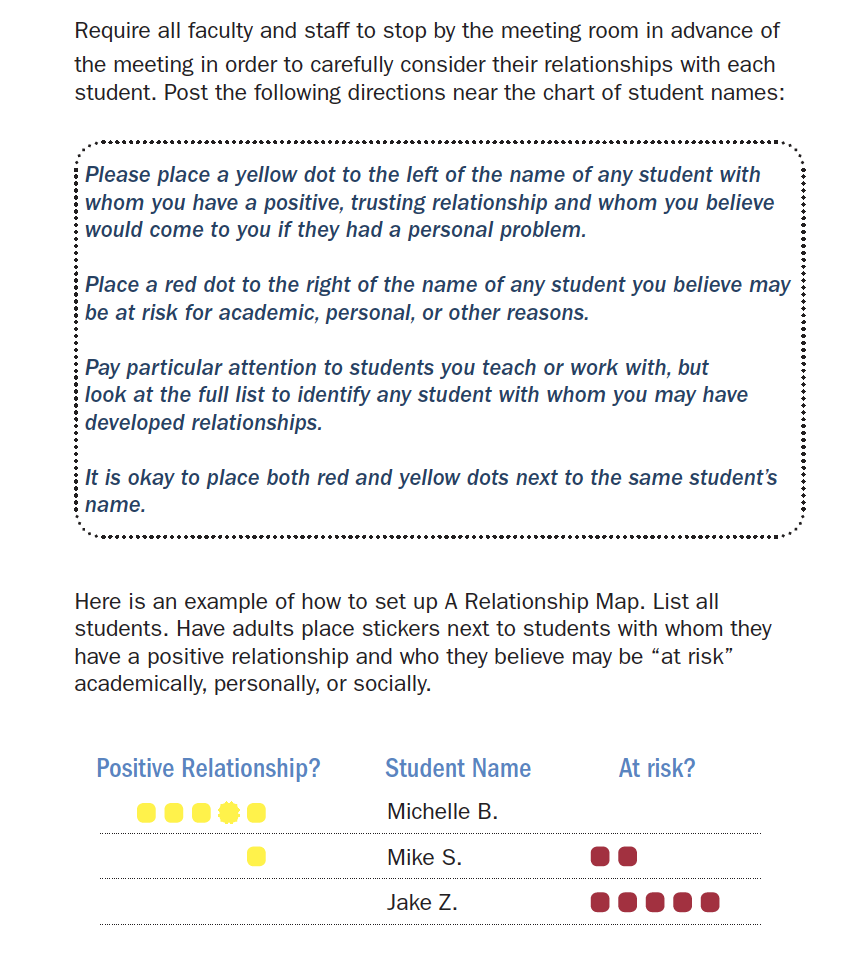
If we focus on knowing our students, demonstrate that we value them as thinkers and learners, and develop positive relationships with them individually and collectively;
then disruptive behavior will decrease, students will be more engaged, and they will feel more connected to the school community
Why it Matters
Teacher, parent, mentor, and peer relationships influence student engagement. Feelings of relatedness, in addition to competence and autonomy, are basic psychological needs (1). When these needs are met, people tend to be more personally motivated, leading to better performance and increased well being. In such relationships, students can thrive, learn, and grow (see Exhibit 1). Research indicates engaging classrooms are both challenging and supportive led by a “warm demander” (see Exhibit 2) (2). The number of strong relationships reported by youth are positively related to academic motivation, socio-emotional skills, and responsibility and inversely related with high-risk behaviors (3). As academic challenge increase the greater the need for relational supports. Children are more motivated and willing to take learning risks when they feel supported by and positively related to others (4). While research suggests positive relationships are important to all students, they appear to matter particularly in adolescence. Middle school students with high levels of teacher support are almost three times more likely to have high levels of engagement (5). Middle school students who reported better student-teacher relationships were 8 times more likely to stick with a challenging task, enjoy hard work, and accept mistakes when learning (6). Unfortunately, quality student-teacher relationships are important but rare. The percentage of students reporting that teachers care and push them to be their best decreased from about a third of students in 6th grade to only 16% in 12th grade (7).
What It Looks and Sounds Like
Of course, there is no one way that making students feel valued, known, and respected will look and sound. There is ample room for individuals to add their own creativity and stamp on things. The list below is a sampling of ideas that might be useful to advance your practice.
Physically greet each student as they enter the classroom by saying, “hello” and their name. This can minimize disruptive behavior and increases engagement.
Correctly pronounce every student’s name. If you’ve got it wrong for a while say: “You know what? I think I’ve been messing up your name all year, and I’m sorry. I want to say it perfectly. Can you teach me?”
Check that your displays and curriculum materials include diverse representation. Make sure that every student can “see themselves” in your classroom.
Use restorative justice practices to approach transgressions with curiosity. Ask, "What happened? What went through your mind at the time? How do you view the event now? Who was affected by your behavior? What do you need to do to repair the damage?" Students won't be able to restore a relationship if they don't understand how their behavior impacted someone.
Build social capital. Get to know your students and build relationships early before you have to troubleshoot.
Be intentional about words, body language, and tone. Show genuine interest, curiosity and care. Avoid sarcasm, it usually backfires.
See and appeal to the best in all students and help them to take responsibility to be better. Ask, ’I’m curious—do you think you've been your best self lately?"
Reflecting on Your Teaching
Reflect on what gets valued, shared, and celebrated in your classroom:
Does my response to student mistakes indicate that mistakes are a sign of failure or an opportunity for learning?
What is celebrated in the classroom: grades, progress, personal growth, something else?
What does the seating arrangement in the classroom communicate? Does it reflect a community orientation?
Are ALL my students’ backgrounds, cultures, genders, neighborhoods, and sexualities represented in the visuals, literature, and examples in my classroom?”
What do I know about each of my students as individuals in terms of their strengths, passions, and interests both in and out of school?
What does my approach to misbehavior say about my desire to build community and be inclusive, forgiving, and supportive?
Using Quick Data to Inform Your Efforts
Use Relationship Mapping to create a visual snapshot of students who are well supported and those most in need of additional support in your school.
Questions to Consider from the Quick Data:
What interesting or surprising details do you notice?
What questions or reflections does the map evoke?
What possible factors contribute to some students having more yellow dots than others? More red dots?
What kinds of school-wide changes can be made to increase the number of yellow dots for students? Decrease the number of red dots?
Connection to the 8 Cultural Forces
Interactions and the relationships that get built through those interactions are the prime cultural force implicated by principle #4. Our interactions must show a respect for and an interest in our students’ thinking, their ideas, and what they contribute to the class community as a whole. It is important that our interactions be sincere, honest, and genuine. This often takes the form of being curious about our students and who they are. It also means approaching misbehavior from a frame of curiosity to try to understand the situation, what motivated it, and how it can be repaired rather than from a punitive stance. Take students seriously as important people who have something to contribute to the world.
Time. Teachers invest time in building quality relationships early in the year. Think of this as social capital that will pay off when the going gets rough or there is a need to troubleshoot or intervene.
Modeling. Through our interactions with students we model how to treat one another and thus build community in our classroom.
Language. When students misbehave, be wary of using words like "should" that carry judgment, and avoid language that assigns blame. Don't say you're "shocked" or "appalled," for example. Similarly, sarcasm, name-calling, and threats are unproductive and only serve to humiliate students. Watch your body language and tone to project both openness and caring. Use “we” to include yourself and create community wherever you can.
Environment. Make sure the physical environment has representations of ALL students’ backgrounds, cultures, genders, neighborhoods, and sexualities in the visuals, literature, and examples in my classroom. Organize seating to facilitate community and communication. Can students see one another when talking?
Routines. Don’t expect students to know how to interact, collaborate, listen or even talk to one another appropriately and effectively at the beginning of the year. Use routines and protocols that help students learn these behaviors.
Opportunities. Create opportunities for growth and challenge while providing support (i.e., be a Warm Demander). Press for thinking and push for quality. Allow students to take risks, try new things, exert control, and learn from their mistakes. Involve students in decision making and share power.
Expectations. Encourage students to live up to their potential and take responsibility for their actions. Communicate that you believe in students not just in the short term but also in the long-haul.
Mindset # 4: Feeling Known, valued, and respected
“Teaching and learning should bring joy. How powerful would our world be if we had kids who were not afraid to take risks, who were not afraid to think and who had a champion? Every child deserves the champion, an adult who will never give up on them, who understands the power of connection, and insists that they become the best that they can possibly be.”
“The key is curiosity, and it is curiosity, not answers, that we model. As we seek to learn more about a child, we demonstrate the acts of observing, listening, questioning, and wondering. When we are curious about a child’s words and our responses to those words, the child feels respected. The child is respected.”
“McLuhan (1964) coined the phrase, ‘The medium is the message’... This phrase aptly describes, too, the influence of the“beingness”of teachers, as the medium through whom messages are sent to their students that model those desired qualities of a culture of respect.”
“Relationships serve to motivate and engage us. They provide a supportive context for taking risks. It helps us to know that someone has our back and is cheering for our success even as they are willing to catch us should we fall.”
“Nothing—nothing—has more impact in the life of a child than positive relationships”
Resources
Video
Interview
Podcast
Article
Blog
Research
10 minutes
How students of color confront impostor syndrome
In this TED talk, Dena Simmons (Teacher and Director of Education, Yale Center for Social Emotional Intelligence) expresses an idea central to this principle: we need loving classrooms that makes students feel proud of who they are.
2 pages
Q&A: Teachers' Cues Shape Students' Sense of Belonging
A Q&A with Dena Simmons (see above Ted Talk) A student's environment relates to their confidence about performing in that environment. The author talks about her experience as a black student in a mostly white boarding school.
21 pages
Breaking the cycle of mistrust: Wise interventions to provide critical feedback across the racial divide
A team of researchers from around the US summarize 3 double-blind studies that looked at how small changes in how teachers give feedback impacts student performance. Effects were generally largest for African American students who felt more mistrust of school.
2 pages
Important Questions to Ask Your Students
Maurice J. Elias puts forth a list of questions for teachers and parents students to uncover what helps them learn, feel valued, and be resilient.
3 pages
Improving Teacher Empathy to Improve Student Behavior
Dr. Robert Brooks explains that empathy is a foundational skill for building meaningful relationships and for a fulfilling, resilient life. He encourages developing an "empathetic mindset" rather than a “default punitive mindset" to enhance teacher-student relationships, promote learning, and lessen disruptive behaviors.
2 pages
Students Care if You Care
Master teacher and middle school math teacher Michele Stassfurth explains why she thinks building a relationship with students is the most important tenet of teaching. Relationships improve your understanding of the student, cultivate mutual respect, and increase student engagement.
6 pages
The Teacher as Warm Demander
Elizabeth Bondy and Dorene D. Ross explain that beyond developing skill in lesson planning, teachers also need to engage students, establish a positive environment by showing children that you care and that you won't give up on them.
8 pages
Creating a Culture of Respect Through Implicit Curriculum.
Linda T. Inlay explains how the affective and overt behaviors of every person in a school setting convey messages about the "hidden" curriculum of the school and influence school culture. This fact is especially true of teachers, who teach "who they are" with every interaction they have with students, parents, and colleagues.
11 pages
On Listening to What the Children Say.
Master kindergarten teacher Vivian Paley uses her experiences to illustrate the importance of listening. To better understand how teacher interactions influenced students, the teacher tape-recorded class conversations.
1 minute
60-Second Strategy: Appreciation, Apology, Aha!.
This short video captures a class using a closing circle activity to build community. Incorporating classroom routines that give students an opportunity to reflect, share, and improve relationships with their peers.
3 pages
The Take Care of Me List.
Middle school teacher Erin Ott explains that she developed the "take care of me list" assignment to communicate clearly that every student matters.
Connecting to “The Who”: The Primacy of Supportive Relationships.
Researcher David .J. Shernoff offers a review of the literature on student relationships and concludes that teacher, parent, mentor, and peer relationships, not just grades, explain why students care about school. This social support is also one of the biggest predictors of student life satisfaction. The impact of relationships appears to increase in adolescence. "Middle school students with high levels of teacher support are almost three times more likely to have high levels of engagement"
14 Minutes
Getting Relationships Right
In this TED talk, Dr. Kent Pekel, CEO of The Search Institute shares five essential actions adults can take to build developmental relationships with young people. Using findings from Search Institute's research and his personal story, Pekel provides powerful but also practical ideas to create connections with kids that put them on the path to thrive. A video discussion guide is included for download.



















